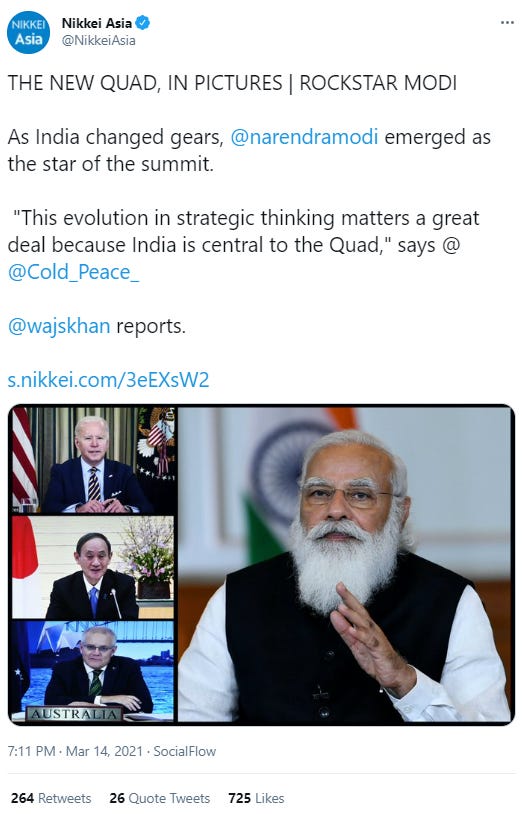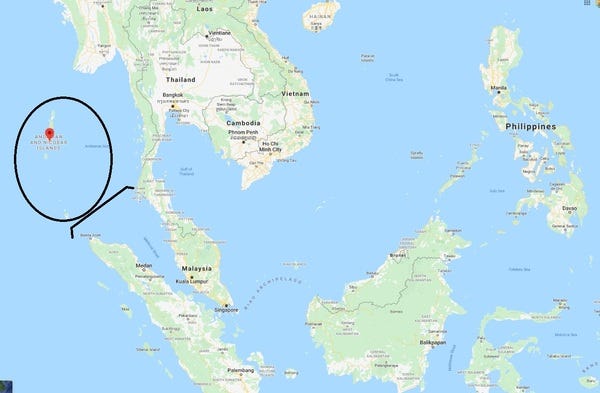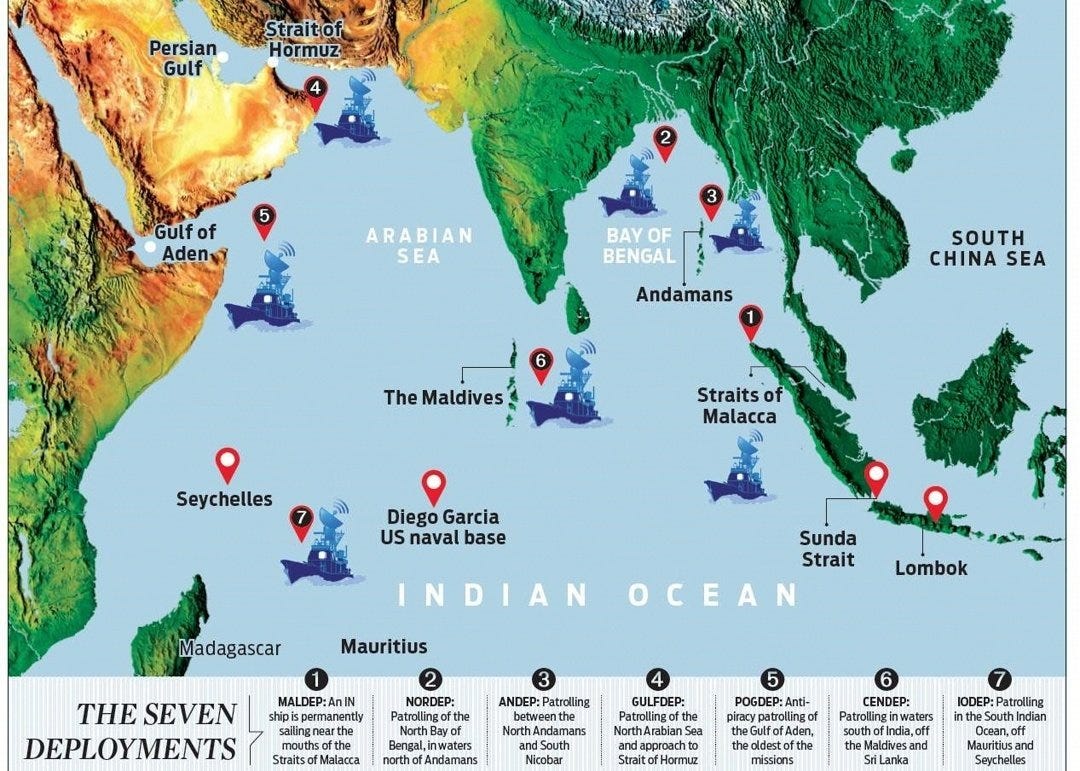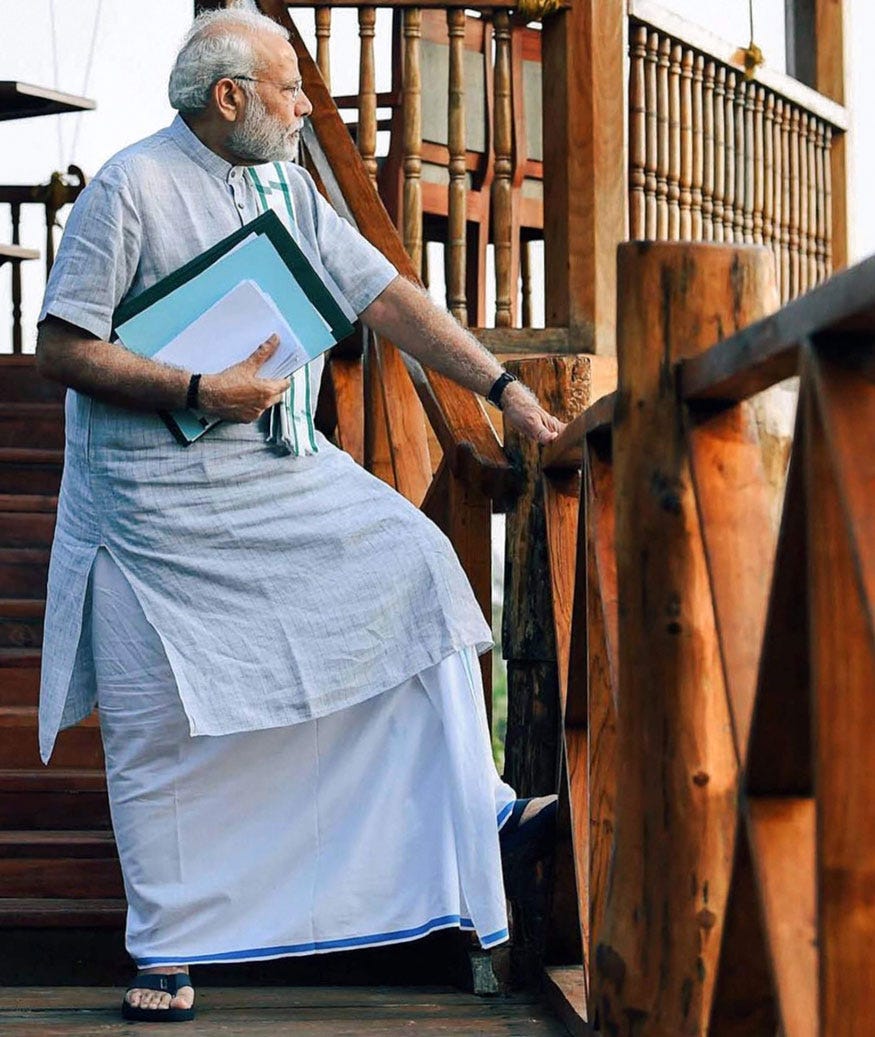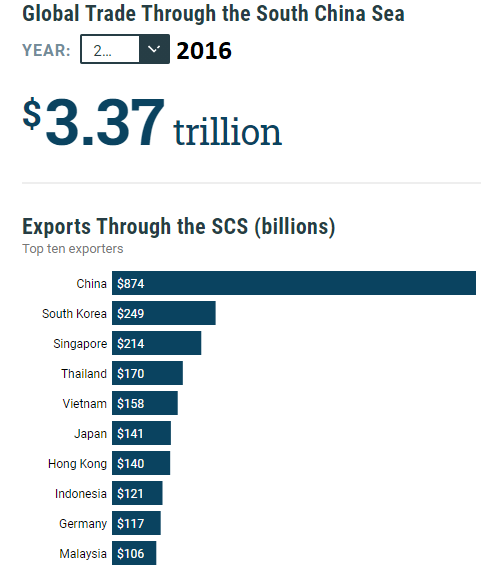Insightful newsletter of Drishtikone: Issue #266 - QUAD and the Future of Global Trade!
QUAD is in news these days. A lot is going on beneath the surface and in many ways, the future of global trade and security is at stake. When you connect dots you realize the sheer genius of Modi!
Image by Christine Sponchia from Pixabay
“Before you judge a man, walk a mile in his shoes. After that who cares? He's a mile away and you've got his shoes!” ― Billy Connolly
Sometimes we look at things in isolation and start commenting on them as if we know what is to be known about it. It is like taking words of say, Krishna or Buddha, and pretending you know what their meaning is.
I am not Krishna. I don’t have his level of perception. Nor his level of consciousness. Whatever I will make of his words will be absolute nonsense.
That is why unless you are in the shoes of someone, really, don’t make interpretations. It is downright foolish.
Modi and his close team is miles ahead of others in terms of the information they have, the experience they bring to bear, and the vision they have brought about together. Let us respect that.
First things first - Yours truly will be exploring #QuestionsofLife with Vivek Agnihotri on VRA TV.


We will start off with our first episode on “What is Destiny?”
That’s 10 AM India Time and Saturday 11.30 PM Central Time in the US, Sunday 3.30 PM Sydney Australia, and Sunday 4.30 AM London Time.
It is not some sermon or giving template answers.
It is an exploration.
A joint exploration of questions that are important to us all.
It is not a debate either. When all you have is a viewpoint, which is experiential as opposed to dogmatic, there is nothing to debate or argue about.
One thing is for sure, it will be interesting and bound to push you to introspect within as well. Just like Vivek and I have loved to do in these episodes.
So join in at the VRA TV on Youtube.
QUAD Summit and Why India’s presence is critical?
We have discussed QUAD repeatedly. In recent weeks, it has gained even more importance. Specifically after the first virtual international summit of the QUAD leaders on March 14th.
India’s participation in a group positioned strongly against China’s growing influence in a way to not just be a mute spectator but to lead it, is a significant step. Traditionally, India has followed an approach of working in an equidistant manner with respect to the large forces in the world.
But no more.
In last week’s summit, India not only got the privilege to announce the summit but India’s PM Modi was the second one to speak after US President Biden.
The QUAD is focused on not just China as an adversary, but on things that are positive and extremely critical to everyone’s interests. Here they are. (Source)
US proposed using Indian-made vaccines to fill the gap in South East Asia from the shortage.
Standard-setting for 5G and other global technologies is a big deal for the QUAD members and in that direction, India and Japan have already signed a memorandum of understanding to work together on the information and communications technologies that include 5G
The issue of cybersecurity is top of the line as well. India, for example, was the second most cyberattacks country in Asia-Pacific in 2020. (Source) Most of these attacks on India involved ransomware.
In India, ransomware (sending suspicious links via emails/messages) to block access to one’s personal files/data) was the most rampant cyber crime accounting for 40 per cent of all attacks
Supply Chains and their dependence on China is another significant issue. The QUAD members want to disperse the SC networks across the four countries and get away from reliance on China. Specifically when it comes to the supply chains for semiconductors and important resources.
Finally, procurement of rare-earth minerals is very critical for future growth as well. Specifically for batteries and high-performance motors.
The experts who were closely watching the summit agreed that the outcomes from the meeting were very significant.
"The deliverables from this summit are big," said Michael Green, senior vice president for Asia and Japan chair at the Center for Strategic and International Studies (Source)
As per the foreign media, the main rockstar at the summit was the Indian PM Modi.
The U.S. Secretary of Defence Lloyd Austin is on his visit to Japan, South Korea, and India in order o build a “credible deterrence” against China.”
Austin’s visit to these countries is being pre-empted by the Chinese in their own way. They are doing a show of strength with their defense toys in the East and South China Seas.
“The PLA Northern, Eastern and Southern theatre commands recently organised combat-oriented exercises in the Yellow Sea, East China Sea and South China Sea respectively,” the Communist Party-run Global Times reported, adding that “in the Yellow Sea, Type 056 and Type 056A corvettes formed a flotilla and practiced training courses including main gun shooting, secondary gun shooting and air defence by launching flares.” “In the East China Sea, Type 052C destroyer Jinan and Type 054A frigate Changzhou ran more than 10 training missions including free combat among warships, submarines and warplanes, and joint fire strikes. In the South China Sea, different types of tug and support ships held maritime search and rescue and emergency towing exercises,” the report said.(Source)
The Chinese Foreign Ministry spokesperson Zhao Lijian, however, called US Defense Secretary’s stand as “Cold-War mentality and ideological prejudice.”
“In the era of globalisation, forming enclosed small cliques with ideology as the yardstick is the sure way to destroy the international order and after all, is unpopular and will end in total failure,” he said. “The U.S. should treat China and China-US relations in a right mentality and in an objective and rational manner, stop interfering in China’s internal affairs, and work with China to focus on cooperation, manage differences, and place China-US relations back on the track of healthy and stable development.” (Source)
Someone is clearly rattled.
PM Modi’s statement at the recent QUAD summit.
Two things are significant:
India is the only country amongst the QUAD members to have had an actual military engagement against China and emerged stronger from it with China losing its face.
India was a reluctant entry into this group but has now made the triangle into a powerful quadrilateral.
Research fellow at the Heritage Foundation, Jeff Smith, says something very interesting:
"The group can only move as quickly as its most reluctant member. Japan, Australia, and the United States are already bound by the thickest of security and intelligence bonds. With India involved at a higher level of strategic coordination, this potent democratic triangle becomes a quadrilateral colossus, accounting for half of the planet's defense spending, and a third of its population and GDP." (Source)
The strength and importance of the Quadrilateral Security Dialogue (or QUAD) are unmistakable. It is now being referred to as the “Asian NATO.”
In December, it is said that the Russia-India summit was canceled due to Russia’s unhappiness over India’s involvement and closeness with this US-led group.
Russia is looking at China to be the one to preoccupy the US in international geopolitics. A more “independent” India - rather one which is still close to Russia - seems to be better for Russia’s calculations. If India gets closer to the US, China is a sitting duck. (Source)
In the past few years, India has inked some remarkably strategic agreements with the United States. Agreements that have brought the two countries very close to each other. Please read Issue #164 - The Saga of LEMOA, COMCASA, and BECA
These are:
Basic Exchange and Cooperation Agreement (BECA) - Signed in 2020
Communications Compatibility and Security Agreement (COMCASA) - Signed in 2018
Logistics Exchange Memorandum of Agreement (LEMOA) - Signed in 2016
General Security of Military Information Agreement (GSOMIA) - Signed in 2002
These are the foundational defense pacts that a country needs to sign to enter into a kind of military alliance and obtain leading-edge weapons and communications systems from the US.
As we saw in our earlier newsletter issue on these agreements, India’s ability to tackle China in Ladakh increased multifold simply due to the access to technology it had thanks to these agreements.
With the QUAD group thrown in, we are looking at a scenario that is bound to upset the Russian calculations.
What is happening is something strategic and very big in terms of geopolitical terms with respect to the maritime rules of engagement.
“The Quad is not an alliance,” said Center for Strategic and International Studies’s Asia and Japan Chairman Michael Greene Monday morning on a press call with CSIS Korea Chairman Victor Cha. “It’s a grouping of maritime powers that essentially want freedom of navigation and a rules-based order. It has, in its current iteration, largely been made possible thanks to Beijing,” he added, referring to China’s excessive maritime claims and aggressive actions against its neighbors. (Source)
That is short-hand for countering China’s growing adventurism in the Southeast Asia region - both in terms of “debt-trap diplomacy” and creation of artificial islands
An extension of that economic cum defense diplomacy that China has been using is the COVID-19 Vaccine Diplomacy. The Chinese are using vaccines in the South-east Asian countries to create influence and counter the negativity against the Chinese that historical prevails in those states.
The politicized nature of the vaccine issue also makes China’s vaccine a convenient tool conflated with domestic politics and nationalism as well. Cambodia’s Prime Minister Hun Sen’s decision to vaccinate his country’s population with 600,000 donated Sinopharm vaccines has sparked some public concerns, which he sought to assuage by asking Cambodians to disregard the origins of the vaccine. Thailand’s decision to withdraw from Covax and rely mostly on Sinovac’s vaccines is also controversial, especially against the backdrop of the ongoing anti-governmental protests. In a recent panel on China’s vaccine diplomacy, a Vietnamese expert also expressed concerns over how to reconcile Vietnam’s domestic anti-China sentiment with inoculating its population with Chinese vaccines. (Source)
To counter this aggressive posture from China, QUAD has taken up vaccine provisions as the central part of its strategy in Southeast Asia.
“Essentially overwhelming China’s very aggressive, wolf-warrior vaccine diplomacy,” Greene said, describing China’s strings-attached approach to diplomacy, which often includes heavily indebting countries in order to reap exclusive mineral and port deals. “It’s a huge play. It’s what Southeast Asians, in particular, have said they want to see from the big powers,” he added. (Source)
It’s a huge play.
Absolutely!
Vaccine distribution around the world is not just good economics. It is a strategic geopolitical move! Specifically for QUAD, if it wants to succeed in its objective of tackling China in the Indo-Pacific region.
And, that is where the remarkable vision of Narendra Modi chalked out last year comes in.
The pledges that QUAD is making for vaccines to Southeast countries, will be fulfilled by India.
Quad leaders also discussed plans to tackle the vaccine shortage in Southeast Asia. According to a Japanese official, Washington proposed using Indian-made vaccines to fill this gap. The prospect of economic benefits to the South Asian country further reduced the hurdles to its participation in the summit. (Source)
Vaccines for power. That’s the play!
To understand why China is in such a state of desperation, you need to see the map of Asia. That small sea route is called the Strait of Malacca.
15.2 million barrels of oil pass through that per day!
The Strait of Malacca and Singapore that small tip at the end of Malaysia link the South China Sea and the Pacific Ocean, thus providing the shortest sea route from the Persian Gulf states to East Asia and the West Pacific areas. Over 70,000 ships go through it and the EIA estimated that 15.2 million barrels of oil a day passed through the strait. It is a major choke point. At its narrowest, it is mere 1.5 nautical miles wide navigable stretch (Philip Channel in Singapore Strait)
The red dot in the circle above is the Andaman Islands.
One of the 7 deployments by the Indian Navy is in that area.
Now go back in your memory to December of 2018. Remember this pic of Modi at Port Blair?
It was heavily trolled then. He was ridiculed and made fun of for just posing for photo-ops. Do you remember that time on Twitter?
While his critics were meme-ing him, he was thinking of something else! Let us see what.
He had gone there to start the project for the underground cable between Chennai and Port Blair. (Source)
That submarine Optical Fibre Cable (OFC) connecting Chennai and Port Blair was finally launched on 10th August 2020. The submarine cable also connects Port Blair to Swaraj Dweep (Havelock), Little Andaman, Car Nicobar, Kamorta, Great Nicobar, Long Island, and Rangat. This connectivity will enable the delivery of faster and more reliable mobile and landline telecom services to Andaman & Nicobar Islands, at par with other parts of India. The foundation stone for this project was laid by the Hon’ble Prime Minister on 30th December 2018 at Port Blair. (Source)
This one move, if combined with increased trade and military presence in Andamans, can change a lot of things geostrategically for India.
It can completely choke the maritime movement for the Chinese goods with India having a closer observation on the movement of ships entering the South China Sea.
Keeping in mind the recent flare-up between India and China, Larry Bond, renowned naval author and creator of the Harpoon war game series, says that if India wanted to block trade with China, all it has to do is its park ships at the mouth of the Malacca Strait. (Source: Eurasiantimes)
That is why China is so heavily vested in the Gwadar Port.
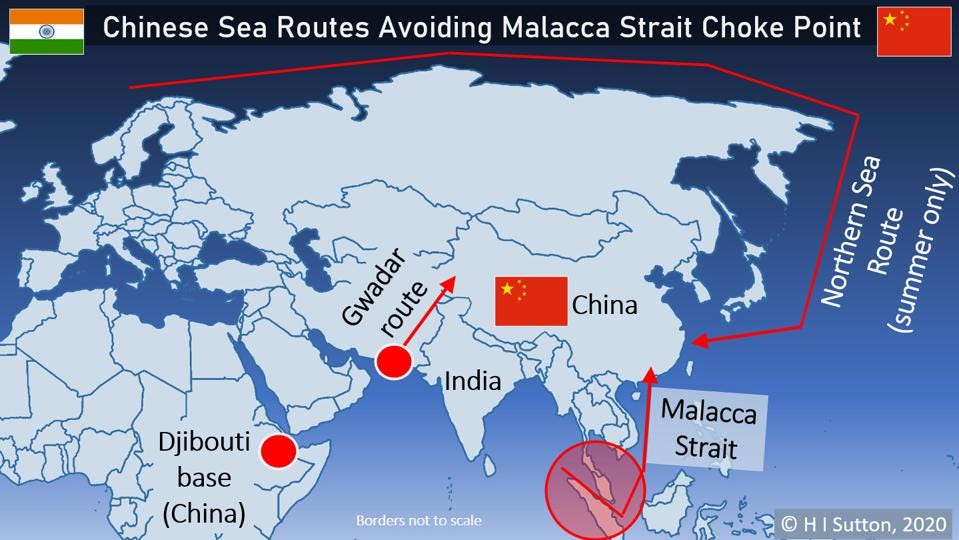
The South China Sea is operative mainly due to the Strait of Malacca. That is why it is the number one choke point in the world! With the Indian naval base of Andaman at its mouth! In layman’s terms, India has China’s neck in its hand. It can simply choke it the day it wants.
Remember 80% of the world trade goes through that narrow sea lane.
The United Nations Conference on Trade and Development (UNCTAD) estimates that roughly 80 percent of global trade by volume and 70 percent by value is transported by sea. Of that volume, 60 percent of maritime trade passes through Asia, with the South China Sea carrying an estimated one-third of global shipping.1 Its waters are particularly critical for China, Taiwan, Japan, and South Korea, all of which rely on the Strait of Malacca, which connects the South China Sea and, by extension, the Pacific Ocean with the Indian Ocean. (Source)
$3.37 Trillion of global trade is dependent on the Strait of Malacca.
Now go back and read this section again - as you go back to every decision that Modi has taken in the last 6 years. Do you now understand why?
market corner: 10 quick bytes
Pandemic influenced 84% of ultra-wealthy Indians to reassess succession planning: Survey - more
Countries halting AstraZeneca vaccine - more
Invest $131 trillion in clean energy by 2050 to hit climate goals, International Renewable Energy Agency says - more
Nokia to cut up to 10,000 jobs over next two years to trim costs - more
India's exports during March 1-14 increase 17% to $14 billion - more
Massive boost to infra along India-China border; Connectivity on 59 strategically important roads achieved - more
China asks Alibaba to dispose of media assets: WSJ - more
Indian Railways will never be privatised: Piyush Goyal in Lok Sabha - more
Indian steel firms to cut Rs 35,000 cr debt between FY21, FY22: Crisil - more
Quad push: ISRO taking space ties with US, Japan and Australia to a higher orbit - more
nota bene
Vaze and Penguin Unraveling: The Antilia bomb scare case is getting murkier by the day. After revelations about the Scorpio car not being stolen, CCTV footage of Vaze’s society procured and possibly damaged by him, and the drivers of Scorpio and Innova cars being under the payroll of the police force, another intriguing disclosure has been made about the ongoing case. A report by TV 9 Marathi report states that Sachin Vaze had an altercation with an official of the State Anti Terrorism Squad (ATS) reportedly over non-compliance of protocols after explosives were found outside the residence of billionaire industrialist Mukesh Ambani. (Source)
New COVID strain kills more: People infected with the coronavirus variant first discovered in the UK have a higher risk of dying from COVID-19 than those who get other versions of the virus. New research published Monday in the journal Nature found that among cases involving the variant, known as B.1.1.7, patients had a 55% higher chance of death within four weeks following their positive test. The study authors examined roughly 2.2 million people who tested positive in England between September and mid-February, then compared the number of deaths among those with B.1.1.7 to those who were infected with other strains. (Source)
SC chides Imran: The apex court of Pakistan expressed disappointment over the Pakistan government's lack of understanding of the need to conduct the CCI, as it was a 'basic requirement to run the country', it observed. The bench further asked the Imran Khan-led government "Despite the government in three provinces, no decision has been taken in the council. Isn't it the responsibility of the Pakistan government to release the results of the census?" it asked. Judge Isa then asked why was the government keeping the CCI report confidential and asked "Are good deeds being kept a secret? It raises questions," Pakistan media was quoted by ANI. (Source)
Manhattan’s Obituary?: Roughly 4 in 5 Manhattan office workers will not return Full-Time, survey says. The Partnership for New York City said major Manhattan employers expect less than half of their employees to be back to the office by September. Some 66 percent said they would adopt a hybrid model of days in the office and days at home, another 9 percent said they would not require workers to return to the office at all, and 4 percent said it would ultimately be role-dependent. (Source)
Chinese Surveillance State: China is building a nightmarish surveillance state with cameras checking emotions and tracking ‘social credit’ with AI. The high-tech systems will also help people snoop and rat on each other from the comfort of their homes — or on the go with their smartphones. The Communist regime's nightmare-inducing plans involve installing spy cameras in all places and using artificial intelligence to calculate a person's "social score" which will determine benefits or punishments. The sheer level of surveillance being planned is straight out of the dystopia created by author George Orwell in his book 1984, where the eyes of the state - Big Brother - are always watching you. (Source)
video corner: Mother’s touch!
Mothers are at the helm of this existence. Nothing can compare to their love or impact. Even the most intense, ruthless, and dispassionate of enlightened beings can break down when they touch the words and memories of their mothers.
This Mahashivratri, this was probably the most poignant moment in the largest celebration on the planet that day.
Today’s ONLINE PAPER: Check out today’s “The Drishtikone Daily” edition. - THE DRISHTIKONE DAILY
Nuzzle Tweets “newsletter” - with tweets and stories that we read and follow in a day in one compilation on a daily basis - Nuzzle Drishtikone - just another way to keep up with things
SUPPORT DRISHTIKONE: If you consider our work important and enriching and would like to contribute to our expenses, please click on the button below to go to the page to send in your contribution. You can select the currency (for example, INR or USD, etc) and the amount you would like to contribute. Contribute to Drishtikone
If you like this post - please share it with someone who will appreciate the information shared in this edition
If you like our newsletter, please share it with your friends and family






